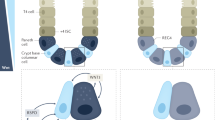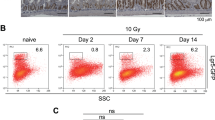Abstract
Intestinal stem cells may have important roles in the maintenance of epithelial integrity during tissue repair. Alemtuzumab is a humanized anti-CD52 lymphocytic antibody that is increasingly being used to induce immunosuppression; intestinal barrier function is impaired during treatment with alemtuzumab. We investigated the response of intestinal stem cells to epithelial damage resulting from alemtuzumab treatment. Intestinal epithelial cell loss and abnormal Paneth cell morphology were found following a single dose of alemtuzumab. The animals receiving alemtuzumab exhibited increased apoptosis in the villi 3 days after alemtuzumab treatment and in the crypt on day 9, but apoptosis was scarce on day 35. We assessed expression of Musashi-1- and Lgr5-positive stem cells following alemtuzumab treatment. Increased numbers of cells staining positive for both Musashi-1 and Lgr5 were found in the stem cell zone after alemtuzumab treatment for 3 and 9 days. These data indicated that the epithelial cells were injured following alemtuzumab treatment, with the associated expansion of intestinal stem cells. After alemtuzumab treatment for 35 days, the numbers of intestinal epithelial cells and intestinal stem cells returned to normal. This study suggests that alemtuzumab treatment induced the increase in stem cells, resulting in the availability of more enterocytes for repair.
This is a preview of subscription content, access via your institution
Access options
Subscribe to this journal
Receive 12 digital issues and online access to articles
$119.00 per year
only $9.92 per issue
Buy this article
- Purchase on Springer Link
- Instant access to full article PDF
Prices may be subject to local taxes which are calculated during checkout







Similar content being viewed by others
References
Bjerknes M, Cheng H . Gastrointestinal stem cells. II. Intestinal stem cells. Am J Physiol Gastrointest Liver Physiol 2005; 289: G381–G387.
Gordon JI, Hermiston ML . Differentiation and self-renewal in the mouse gastrointestinal epithelium. Curr Opin Cell Biol 1994; 6: 795–803.
Potten CS, Booth C, Pritchard DM . The intestinal epithelial stem cell: the mucosal governor. Int J Exp Pathol 1997; 78: 219–243.
Okamoto R, Tsuchiya K, Nemoto Y, Akiyama J, Nakamura T, Kanai T et al. Requirement of Notch activation during regeneration of the intestinal epithelia. Am J Physiol Gastrointest Liver Physiol 2009; 296: G23–G35.
Okamoto R, Watanabe M . Molecular and clinical basis for the regeneration of human gastrointestinal epithelia. J Gastroenterol 2004; 39: 1–6.
Potten CS . A comprehensive study of the radiobiological response of the murine (BDF1) small intestine. Int J Radiat Biol 1990; 58: 925–973.
Kayahara T, Sawada M, Takaishi S, Fukui H, Seno H, Fukuzawa H et al. Candidate markers for stem and early progenitor cells, Msi-1 and Hes1, are expressed in crypt base columnar cells of mouse small intestine. FEBS Lett 2003; 535: 131–135.
Potten CS, Booth C, Tudor GL, Booth D, Brady G, Hurley P et al. Identification of a putative intestinal stem cell and early lineage marker; Msi-1. Differentiation 2003; 71: 28–41.
Barker N, van Es JH, Kuipers J, Kujala P, van den Born M, Cozijnsen M et al. Identification of stem cells in small intestine and colon by marker gene Lgr5. Nature 2007; 449: 1003–1007.
Garcia M, Weppler D, Mittal N, Nishida S, Kato T, Tzakis A et al. Campath-1H immunosuppressive therapy reduces incidence and intensity of acute rejection in intestinal and multivisceral transplantation. Transplant Proc 2004; 36: 323–324.
Shapiro R, Ellis D, Tan HP, Moritz ML, Basu A, Vats AN et al. Alemtuzumab pre-conditioning with tacrolimus monotherapy in pediatric renal transplantation. Am J Transplant 2007; 7: 2736–2738.
Stanglmaier M, Reis S, Hallek M . Rituximab and alemtuzumab induce a nonclassic, caspase-independent apoptotic pathway in B-lymphoid cell lines and in chronic lymphocytic leukemia cells. Ann Hematol 2004; 83: 634–645.
Knechtle SJ, Pirsch JD, Fechner H, Becker BN, Friedl A, Colvin RB et al. Campath-1H induction plus rapamycin monotherapy for renal transplantation: results of a pilot study. Am J Transplant 2003; 3: 722–730.
Walsh R, Ortiz J, Foster P, Palma-Vargas J, Rosenblatt S, Wright F . Fungal and mycobacterial infections after Campath (alemtuzumab) induction for renal transplantation. Transpl Infect Dis 2008; 10: 236–239.
Heider U, Fleissner C, Zavrski I, Jakob C, Dietzel T, Eucker J et al. Treatment of refractory chronic lymphocytic leukemia with Campath-1H in combination with lamivudine in chronic hepatitis B infection. Eur J Haematol 2004; 72: 64–66.
Li QR, Zhang Q, Wang CY, Li YX, Wu B, Liu XX et al. Alteration of tight junctions in intestinal transplantation with use of alemtuzumab (Campath-1H). Clin Immunol 2009; 132: 141–143.
Cadwell K, Liu JY, Brown SL, Miyoshi H, Loh J, Lennerz JK et al. A key role for autophagy and the autophagy gene Atg16l1 in mouse and human intestinal Paneth cells. Nature 2008; 456: 259–264.
Qu LL, Li QR, Jiang HT, Gu LL, Zhang Q, Wang CY et al. Effect of anti-mouse CD52 monoclonal antibody on mouse intestinal intraepithelial lymphocytes. Transplantation 2009; 88: 766–772.
Loisel S, Ohresser M, Pallardy M, Dayde D, Berthou C, Cartron G et al. Relevance, advantages and limitations of animal models used in the development of monoclonal antibodies for cancer treatment. Crit Rev Oncol Hematol 2007; 62: 34–42.
Roberts SA, Hendry JH, Potten CS . Intestinal crypt clonogens: a new interpretation of radiation survival curve shape and clonogenic cell number. Cell Prolif 2003; 36: 215–231.
Brittan M, Wright NA . Stem cell in gastrointestinal structure and neoplastic development. Gut 2004; 53: 899–910.
Barker N, van de Wetering M, Clevers H . The intestinal stem cell. Genes Dev 2008; 22: 1856–1864.
Bloom DD, Hu HZ, Fechner JH, Knechtle SJ . T-lymphocyte alloresponses of campath-1H-treated kidney transplant patients. Transplantation 2006; 81: 81–87.
Cheng H, Bjerknes M . Whole population cell kinetics and postnatal development of the mouse intestinal epithelium. Anat Rec 1985; 211: 420–426.
Clarke RM . The effect of growth and of fasting on the number of villi and crypts in the small intestine of the albino rat. J Anat 1972; 112: 27–33.
Dekaney CM, Fong JJ, Rigby RJ, Lund PK, Henning SJ, Helmrath MA . Expansion of intestinal stem cells associated with long-term adaptation following ileocecal resection in mice. Am J Physiol Gastrointest Liver Physiol 2007; 293: G1013–G1022.
Acknowledgements
This work was supported by the National Basic Research Program (973 Program) in China (nos. 2009CB522405 and 2007CB513005), the Key Project of National Natural Science Foundation in China (30830098), the National Natural Science Foundation in China (81070375), the Scientific Research Fund in Jiangsu Province (BK2009317), the National Key Project of Scientific and Technical Supporting Programs Funded by the Ministry of Science and Technology of China (2008BAI60B06) and the Military Scientific Research Fund (0603AM117). We thank the Deutscher Akademischer Austauschdienst Researcher Fellowship (Bioscience Special Program, Germany) on behalf of Dr Qiurong Li.
Author information
Authors and Affiliations
Additional information
Note: Supplementary information is available on the Cellular & Molecular Immunology website.
Supplementary information
Rights and permissions
About this article
Cite this article
Li, Q., Zhang, Q., Wang, C. et al. The response of intestinal stem cells and epithelium after alemtuzumab administration. Cell Mol Immunol 8, 325–332 (2011). https://doi.org/10.1038/cmi.2011.10
Received:
Revised:
Accepted:
Published:
Issue Date:
DOI: https://doi.org/10.1038/cmi.2011.10



